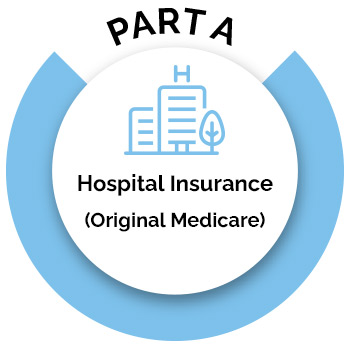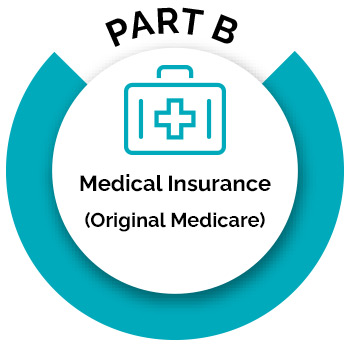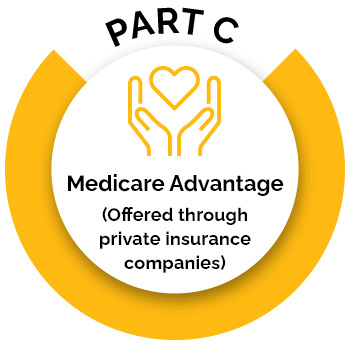
by SaludVIP | Jul 23, 2022 | Blog
Medicare is a federal health insurance program that affects millions of seniors every year. It makes healthcare coverage possible for adults 65 and older as well as younger individuals with disabilities.
And although 62 million Americans are currently enrolled in Medicare, very few actually truly understand it and all its layers. Medicare on its own can be confusing, but once you start talking about its different parts – A, B, C, and D – it’s enough to overwhelm even those who are insurance savvy.
Breaking Down Medicare
Selecting the right benefits to cover services you specifically need is crucial in keeping your costs low. Not taking the time to fully understand what you’re signing up for can result in higher premiums, out-of-pocket drug costs, and even paying more in taxes.
Original Medicare and Medicare Advantage are terms used when discussing the healthcare program. Simply put, Original Medicare includes Part A and Part B. Medicare Advantage is an “all in one” alternative known as Part C. There’s also Part D that you can add to Original Medicare as a type of supplemental coverage.
Let’s take a closer look at each individual part and what it covers.
What is Part A?
Part A is what’s considered hospital insurance. In a nutshell, it covers hospital visits, skilled nursing facility care, nursing home care, hospice care, and home health care.
So, for example, if you were admitted into the hospital, Part A would help cover the cost of common expenses, such as a semi-private room, meals, and nurse care.
If you have turned 65 and you or your spouse worked and paid Medicare taxes for at least 10 years, you are eligible for Medicare Part A. Most eligible individuals do not have to pay premiums for Part A; however, there is a deductible and a coinsurance responsibility for beneficiaries.
Even though Part A is “hospital coverage,” not everything that happens at the hospital falls under that umbrella. For example, some hospital care and procedures ordered by physicians fall under Part B.
What is Part B?
Part B can be compared to what we know as basic health insurance. It covers outpatient services that are medically necessary, such as doctor visits, lab work, diagnostic testing, surgeries, chemotherapy, preventive treatment, and most other ambulatory services.
Part B does have a premium that beneficiaries are responsible for. But just like with other types of insurance, prices vary depending on several factors, including income and marital status.
You don’t have to purchase Part B, but together, Part A and Part B make up Original Medicare. Most individuals sign up for parts A and B when applying for social security.
What is Part C?
Part C is what’s referred to as Medicare Advantage. It’s different from Part A and B in that it’s an actual comprehensive Medicare-approved health plan that you purchase from a private insurance company. Coverage includes Part A and B benefits, along with some Part D (more on that later). In addition, other preventive services such as vision, dental, and hearing are also included. It’s basically all the parts rolled into one convenient plan.
With Part C, you have a network of physicians within your service area that you can select from for services. This helps to lower premiums and limit your out-of-pocket expenses. In addition, most Part C plans help keep you from having to run all over the place for treatment because you must stay in-network.
Unlike Original Medicare, where you get what you get, Medicare Advantage allows you to pick a specific insurance plan from a provider that caters to your particular needs.
What is Part D?
Part D is entirely optional and must be purchased separately from a private insurance carrier. It is a federal program that provides prescription drug coverage to individuals who receive Original Medicare.
With Part D, you will have a monthly premium, and in return, you will receive significantly lower copays on medicine and prescription drugs. If you receive Part A and Part B, Part D is a separate plan; however, Medicare Advantage plans have a built-in drug plan so Part D is not necessary.
What Medicare Parts Do I Need?
When it comes to what coverage you need, it’s entirely personal and varies from person to person. There is no one-plan-fits-all, and there are pros and cons to each part.
One thing to note, however, is Medicare enrollment eligibility for the various parts and plans changes depending on your age, what you are currently enrolled in, and whether you have moved or had a life change. There are only certain times during the year when you can change/add plans or switch from Original Medicare to Medicare Advantage.
Need Help? Contact SaludVIP Today!
If you’re still confused about Medicare and what parts you need, contact us at SaludVIP, and we’ll be happy to answer all your questions and discuss your options.

by SaludVIP | Jul 23, 2022 | Blog
For older adults, health care costs account for about 9% – 14% of household spending. Medicare, the government’s health care program for people age 65 and older, is a way to manage those costs. It can get confusing, though. What is a Medicare Advantage plan? Is it different from Original Medicare? What do the plans cover?
It can be a lot to digest. Let’s break it down to the basics so you’ve got a good foundation to decide if this is a good route for you to take.
What is Medicare
Medicare is the government-run health insurance program that covers people age 65 and older, some younger people with disabilities, and people with End-Stage Renal Disease.
The two main options for coverage are Original Medicare and Medicare Advantage. In this section, we’re talking about Original Medicare, which includes Part A and Part B.
What Part A Covers
Medicare Part A is basically your hospital insurance. It covers hospital visits, skilled nursing facility care, nursing home care, hospice care, and home health care.
There is a deductible for Part A, as well as a coinsurance you’ll have to pay. That coinsurance doesn’t kick in until after a 60-day stay at an inpatient facility.
What Part B Covers
Part B is more like your traditional medical insurance. It covers your doctor visits, mental health visits, ambulance services, services and supplies used to diagnose or treat a medical condition, and preventive services.
You’ll pay a monthly premium for Medicare Part B. That price varies based on things like your marital status and income.
What Part A and Part B Don’t Cover
While Original Medicare might cover the majority of your healthcare needs, it’s important to factor in what it won’t cover before you enroll. Those things include:
- Long-term care
- Most dental services
- Dentures
- Eye exams for getting prescription eyeglasses
- Cosmetic Surgery
- Hearing aids
If you would like prescription drug coverage, there’s an additional plan called Part D that you’ll need to join.
If there’s a specific test, item, or service you’re wondering about, the Medicare website has a search feature to help you find out.
What is a Medicare Advantage Plan
Also called Part C, Medicare Advantage Plans are an alternative to Original Medicare. These plans are provided by private insurance companies that are approved by Medicare. Think of them as an all-in-one option.
Essentially, these are bundled plans that will include benefits like Part A, Part B, oftentimes Part D, and other things like vision, hearing, and dental coverage.
The packages can have some other perks that you might not usually think about, like assistance for fitness programs, over-the-counter drugs, and even transportation to and from doctor visits.
The cost of Medicare Advantage Plans will vary depending on which insurance provider you go with. There will also be certain stipulations based on what providers are in the plan’s network and the service area.
Pros and Cons of Medicare Advantage Plans
While Medicare Advantage Plans are a great option for some people, others may not need the amount of coverage provided.
Here are some things to consider.
Pros
Medicare Advantage plans can offer more personalized benefits based on your situation. With Original Medicare, the extent of your coverage is already laid out. Going the Advantage route will give you some more flexibility to cater your plan to fit your needs.
In that same vein, you’ll also get more convenient options for your coverage. You can wrap everything up into one plan. If you take the Original Medicare route, you would have to add Part D coverage if you want a prescription drug plan, for example.
There is potential to save money with Advantage plans, too. Some of this type of plan will come along with lower premiums and set limits on the maximum amount you will have to pay out of pocket during the year.
Cons
You are likely to be more limited in healthcare providers you can choose from with an Advantage plan. Since this is run through private insurance companies, you are probably going to face the old in-network versus out-of-network provider dilemma. That’s dependent on the plan you choose, but it’s still important to keep in mind.
Speaking of the plans, there are a lot of them to choose from. The number of available options can make it more complex to choose a plan. It can get overwhelming trying to narrow them down.
Finally, Medicare Advantage Plans may only offer coverage in specific areas. That means if you end up moving you may also have to change your plan. By contrast, Original Medicare has the same coverage no matter where you are in the country.

by SaludVIP | Jun 7, 2022 | Blog
Emergencies and Services of Medical Institutions
Hospitals, urgent care clinics, and primary care offices are all institutions that help patients and customers by providing medical and surgical treatment, as well as nursing care for sick and injured people whenever needed.
Although they are all focused on providing medical care, each of these are different in certain ways, created with a unique purpose and target audience in mind, and thus treat patients and illnesses very differently from one another according to their priorities.
It’s important for patients to understand the purpose behind the different types of medical institutions and what each one is designed to treat, and knowing those differences can be very beneficial for future emergencies and situations while also keeping costs low.
Services
Distinguishing between all three medical services is the first step to understand when to visit them for medical reasons, as well as knowing the services they provide.
Primary care offices are designed for preventive care and minor medical problems, they normally operate during regular business hours and have a doctor managing the practice. Generally, they encourage and incentivize patients to visit their doctor regularly and to perform all routine check-ups to keep their health in good condition, and they are also a low cost option for routine medical services compared to the emergency room or the hospital system.
Urgent care clinics, as its name indicates, are for more serious injuries that, although not life-threatening, can’t simply be treated by a primary care office. These patients need to be treated immediately to prevent any possible complications and are open 24/7 for any need.
Although the cost is higher compared to primary care, it’s much less compared to hospitals, which are much more costly depending on the treatment or surgery. Despite this, hospitals and emergency rooms are designed to tackle any condition that could cause death or permanent injury, and they are also open 24/7 to be ready for any patient whose life could be at risk.
Illnesses and Emergencies
Primary care offices focus on minor illnesses or injuries that can be treated quickly or prevented to improve patient well-being, including advice on managing regular body functions or managing weight, controlling chronic diseases such as diabetes and high blood pressure, and even tackling mental health.
Urgent care clinics handle accidents, infections, minor bleeding, broken bones, and other conditions that are deemed as priorities to ensure the safety of the patient.
Hospitals are equipped to handle almost any kind of emergency, especially bigger surgeries and life-threatening emergencies that the other institutions can’t handle. These include chest pain, severe bleeding, burns, strokes, difficulty breathing, and other grave illnesses that leave patients in critical condition and must be treated immediately.
Minor conditions such as fevers or sprains are considered as “non-emergencies”, which will take much longer to be treated and won’t be prioritized compared to the serious illnesses.
Learning about each of the services that the different medical institutions provide to manage every emergency is crucial to prevent any costs and maximize your benefits. At SaludVIP, we strive to give the best medical primary care possible to our patients and bring unique experiences to them, making them feel comfortable and at home as we help them find the road to a Better Health.
You can call us at 844-912-5292 or visit our website to learn more about us and the medical service we provide.

by SaludVIP | Jun 6, 2022 | Blog
You’ve been invited to the Better Health Club!
At SaludVIP, our patients are our top priority.
We want to bring you the best care and make you feel close to home.
It’s the perfect match for people with Medicare & Medicare Advantage.
Come join our big family and let us be your partners in the pursuit of Better Health!
Don’t miss out!
There are only a few new patient slots left.
Call us to schedule your VIP Tour and learn how we are transforming health care:

844-912-5292













